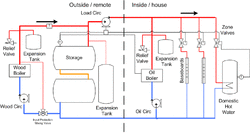Working on my EKO 60 install.....
I put up a 60'x40' shop with an attached boiler room. The boiler is 210' from the house. I plan to heat both the shop and house with the EKO.
Due to space limitations in my basement, I'm going to locate the storage (1000 gal) in my boiler room.
I've read about piping schemes, but I can't seem to get storage piping thru my head.
I've got most of the copper run from the boiler...circ pump, danfoss, air scoop, etc...are all in place. I'm to the point where I have to connect to the house supply/return and also tie in the storage.
Now.....my primary concern is first, keeping the supply to the house up to temp, then heating the shop, and finally storage.
How do I divert to storage when nothing else is calling for heat? Which then leads me to wondering how do I pull from storage when needed?
Also..in the sequential flow of piping from boiler, should I tee for storage before I connect to the underground run to the house, or after?
Any chance someone can explain (in layman's terms) how this works? For the most part, I "think" I understand the basic piping; it's the control logic that has me baffled....
Thanks for any input.
I put up a 60'x40' shop with an attached boiler room. The boiler is 210' from the house. I plan to heat both the shop and house with the EKO.
Due to space limitations in my basement, I'm going to locate the storage (1000 gal) in my boiler room.
I've read about piping schemes, but I can't seem to get storage piping thru my head.
I've got most of the copper run from the boiler...circ pump, danfoss, air scoop, etc...are all in place. I'm to the point where I have to connect to the house supply/return and also tie in the storage.
Now.....my primary concern is first, keeping the supply to the house up to temp, then heating the shop, and finally storage.
How do I divert to storage when nothing else is calling for heat? Which then leads me to wondering how do I pull from storage when needed?
Also..in the sequential flow of piping from boiler, should I tee for storage before I connect to the underground run to the house, or after?
Any chance someone can explain (in layman's terms) how this works? For the most part, I "think" I understand the basic piping; it's the control logic that has me baffled....
Thanks for any input.


